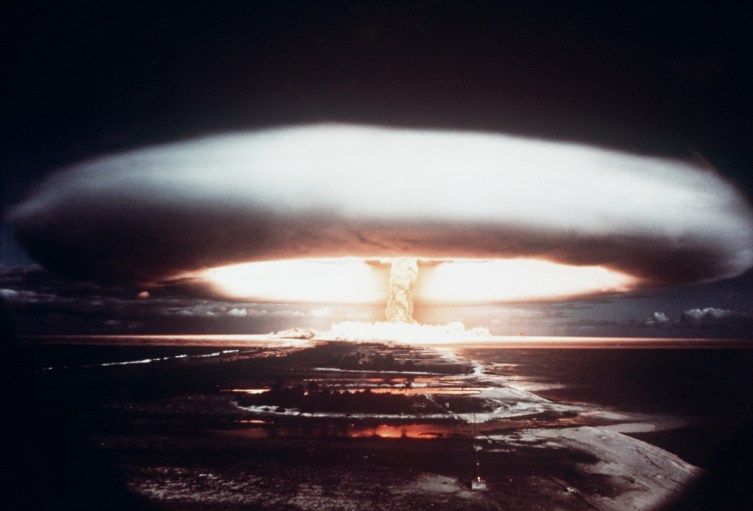E.U. foreign-policy chief Catherine Ashton speaks with Iranian Foreign Minister Mohammed Javad Zarif on Nov. 7, 2013 before the start of two days of closed-door nuclear talks in Geneva
A new round of negotiations with Iran over its nuclear program convenes in Geneva on Thursday. And there’s growing optimism about the talks.
“For the first time, Iran appears to be committed to moving this negotiation process forward quickly,” a senior Obama administration official told reporters in Geneva on Wednesday. “For the first time, we aren’t seeing them use this negotiating process simply to buy time.”
But while most people grasp the core problem here — Iran is thought to be working toward a nuclear bomb — the particulars can be confounding to a layperson. So for those without the time or inclination to absorb all the complicated details, here’s a crash course, in five pictures and about 3 minutes, on the key factors that could decide the difference between a historic diplomatic feat and another hellish Middle East war.
1. THIS STUFF
Uranium, the mineral at the root of this whole crisis, is relatively harmless in its original, mined form. But Iran is refining large amounts of uranium into a frighteningly potent fissile material with…
2. THESE MACHINES
Spinning tubes which rotate a hundred times faster than your washing machine, centrifuges “enrich” uranium into bomb-grade fissile material by separating its more potent components from the less volatile stuff. Iran now has about 18,000 of these centrifuges (the ones pictured here are American). A key issue is whether Iran will be allowed to keep any of them under a deal in which the U.S. and its negotiating partners — Germany, China, Russia, Great Britain and France — agree to lift their punishing economic sanctions.
U.S. and Israeli hard-liners say Iran must give up all its centrifuges to ensure it can never produce a bomb. Iran, which denies it wants a nuke, insists it has a right to enrich nuclear fuel for energy, medical and research purposes. A deal might allow Iran to keep some centrifuges, but not enough of them to quickly enrich enough uranium for a bomb in a place like…
3. THIS MOUNTAIN
Thousands of Iran’s centrifuges spin away at Fordow, an underground facility near the Iranian holy city of Qom. The U.S. insists that Iran must shut down Fordow, which was built in secret and only discovered a few years ago, lending credence to the argument that Iran was stealthily trying to a bomb. The facility is especially worrisome because, unlike other Iranian nuclear sites, it’s burrowed hundreds of feet under mountain rock. That might make it impervious to attack by…
4. THESE PLANES
Hanging over the talks is the prospect that Israel will unilaterally strike Iran’s nuclear facilities if its leadership, including Prime Minister Benjamin Netanyahu, believes Tehran has enough highly-enriched uranium to build a bomb. President Barack Obama also says he’d use military force if needed to prevent Iran from getting a nuke, but Israel’s threat is generally considered more credible. At the same time, the Israeli military is less powerful than America’s and may only be able to dent Iran’s program, not cripple it. Whether force becomes necessary may depend on the thinking of…
5. THIS MAN
While attention has centered around Iran’s moderate new president, Hassan Rouhani, the ultimate authority remains the country’s Supreme Leader, Ali Khamenei. Western observers describe Khamenei as clever but paranoid, and consumed with loathing and distrust for the west. Khamenei may feel that possessing a nuclear bomb is Iran’s sole guarantee against an American invasion like the one in neighboring Iraq. At the same time, he must heed the growing discontent within his country over the international sanctions.
Although skeptics still doubt whether either side is prepared to trust the other, the talks appear to be making some progress. A key goal of this week’s meetings will be to strike an interim deal, in which both sides make some concessions, as a trust-builder for a broader agreement. Gary Samore, a former top Obama White House aide who handled the Iran issue tells TIME that he sees “a reasonable chance” for such a deal before Christmas. “I think both sides want it enough, and that the Iranians are actually negotiating instead of just posturing, which is what they’ve been doing for the past five years,” Samore says.
The longer-term stakes are enormous, including the scary prospect of war and major economic disruption. But an agreement after a decade of confrontation could mean that the U.S. and Israel don’t have to worry about…
and Iran can stop worrying about
And maybe everyone can live in peace.
MORE: The Incredible, Absurd Iranian Hostage Rescue Mission That Never Happend








